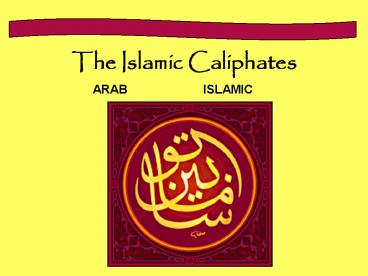The Islamic Caliphates - PowerPoint PPT Presentation
Title:
The Islamic Caliphates
Description:
The Islamic Caliphates ARAB ISLAMIC Historic Period Review Ancient Period Classical Period Post-Classical Period Rise of Islam Umma- Muslim Religious Community Imam ... – PowerPoint PPT presentation
Number of Views:77
Avg rating:3.0/5.0
Title: The Islamic Caliphates
1
The Islamic Caliphates
ARAB
ISLAMIC
2
Historic Period Review
- Ancient Period
- Classical Period
- Post-Classical Period
3
Rise of Islam
- Umma- Muslim Religious Community
- Imam
- Quran (koran)
- Hadith
- Sharia Law
- Five Pillars of Islam
- Confession of Faith
- Prayer
- Fasting
- Alms
- Hajj
4
Rise of the Caliph
- The Caliph
- Theocracy
- Growth of Islam linked to growth of its Empire
- Abu Bakr
- First Caliph
- Sunnis vs. Shia
- Umar, Uthman, and Ali Followed
- Ali assassinated, makes way for Umayyad Dynasty
5
(No Transcript)
6
The Umayyad Dynasty
- New Capital
- Mecca Remains Spiritual Center
- Arabic Becomes official Language
- Standard Money Unit
- Gold and Silver Coin
- Subjects encouraged to convert
- Extra tax on those who did not convert
- Enormous Expansion
- Charles Martel stops Muslims at Spain
7
The Dome of the Rock
8
Rise of Abbasid Dynasty
- 750 to 1258 A.D.
- Abu al-Abbas
- Shia and Mawali were his allies.
- Mawali (Islamic converts) also supported him to
gain acceptance in the community of believers. - Battle of River Zab
- Reconciliation Banquet
- Bad day for the Umayyad
- 750 A.D. Abbasid replaced Umayyad in all areas
except Spain
9
Early Abbasid Era
- Began to reject Shia and Malawi allies
- Defended Sunni Islam.
- Built a centralized, absolutist imperial order.
- New capital Baghdad The Round City on Tigris
River - Baghdad became the richest city in the
- world (only Constantinople came close)
- Golden Age
- Sat on jeweled thrones. Had palaces and harems!
Image of elitism was important. - For more than a century, able to collect revenue
and preserve law over much of the empire.
10
AbbasidArt
11
Islamic Conversion and Mawali Acceptance
- Mass conversions to Islam were encouraged
throughout the empire. - Tolerant of other cultures/traditions
- Sufis
- Most converts were won over peacefully because of
appeal of Islamic beliefs and advantages they
enjoyed - - didnt have to pay head tax
- - educational opportunities
- - jobs as traders, administrators, judges
12
Town Country Commercial Boom and Agrarian
Expansion
- Abbasid Era was a great time of urban expansion
and growth of merchant and landlord classes. - Tang Song Dynasties in China were also reviving
middle merchant class. (results of falls of
Rome/Han) - Arab DHOWS - trading vessels with triangular
(lateen) sails were used from Mediterranean to S.
China Sea. This style later influenced European
ship design.
13
Town Country Commercial Boom and Agrarian
Expansion, cont..
- Muslim merchants formed joint ventures with
Christian and Jewish traders. - Because each merchant had a different Sabbath,
they could work 7 days/week. - Merchants grew rich supplying cities with goods
throughout the empire. - Much wealth went to charity (required by Quran).
- Hospitals and medical care of the Abbasid Empire
surpassed those of any other civilization of that
time.
14
Town Country Commercial Boom and Agrarian
Expansion, cont..
- Hospitals and medical care
- Abn al-Sina (Avicenna)
- Mohammad al-Razi
- Credit System
- Itemized Receipts and Bills
- Much unskilled labor was left to slaves.
- Some slaves were able rise to positions of power
and gain freedom - Huge estates might have slaves, indentured
servants or sharecroppers.
15
The First Flowering of Islamic Learning
- Early contributions from Abbasid were great
mosques and palaces. Ex Dome of the Rock - Advances in religious, legal and philosophical
discourse. - Science and Math! Abbasid scholars preserved
Greek works of medicine, algebra, geometry,
astronomy, anatomy, and ethics. - Arabic traders in India carried the Indian number
system across Mediter. and into Northern Europe.
These number systems became ESSENTIAL to
Scientific Revolution in W. Europe.
16
Global Connections Early Islam the World
- Abbasid Empire was the go-between for the
ancient civilizations of the Eastern
Hemispherethis role grew as Arab trade networks
expanded. - Islam pioneered patterns of organization and
thinking that would affect human societies in
major ways for centuries. - 5 Centuries Spread of Islam played a dominant
role in the Afro-Eurasian World.
17
Global Connections Early Islam the Worldcont.
- In the midst of achievement, Muslims were people
that had some growing disadvantages, especially
to Europeans. - Muslim divisions would leave openings for
political problems. - Growing intolerance and orthodoxy led to the
belief that the vast Islamic world contained all
requirements for civilized life, which caused
Muslim people to grow less receptive to outside
influence and innovationsled to isolation at a
time when Christian rivals were in a period of
experimentation and exploration.
18
Decline of the Caliphates
- Internal Struggles and Civil War
- Sunnis vs. Shia
- Different Ethnic Groups
- Destabilized Central Power
- Threats from Seljuk Turks, Persians, Europeans
and Byzantines - Mongols deal final blow
- 1258 overran Islamic Empire and destroyed Baghdad
- Ottoman Turks































